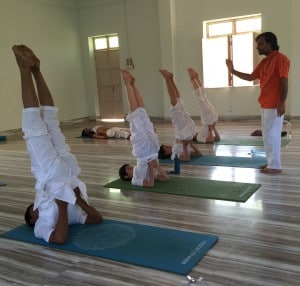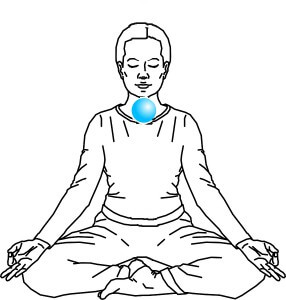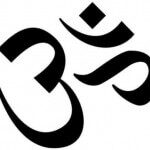 My journey with Sarvangasana started years ago. It is a journey I didn’t realize I was on! As a child, my brother and I used to play, doing shoulder stands and lots of acrobats. Like most children we didn’t pay attention to any of the details of this play – alignment or benefits. It was our childish fun. We laughed. We fell a lot. And we were red in the face.
My journey with Sarvangasana started years ago. It is a journey I didn’t realize I was on! As a child, my brother and I used to play, doing shoulder stands and lots of acrobats. Like most children we didn’t pay attention to any of the details of this play – alignment or benefits. It was our childish fun. We laughed. We fell a lot. And we were red in the face.
Then in my early twenties I started practicing Yoga – another unexpected journey. And there it was again – shoulder stand had re-entered my life as Sarvangasana. But this time it had an aim, a purpose. Behind it was theory, alignment, and sequencing ideas. I was being asked to concentrate on this asana, a requirement for keeping the position calm and relaxed. Others struggled with it. But me ““ I was doing this fun since childhood! Easy, right? On the outside it looked fine, nobody ever corrected me. So for years I missed the essence of Sarvangasana. Doing it consistently wrong, the weight of my body always laid fully on the cervical vertebrae. Instead of acknowledging the pain and finding a better way, I suffered through it like a regretful chore, assuming everyone felt this way, or that I wasn’t strong/straight/flexible enough. In this way I did not profit from the posture and luckily I didn’t harm myself permanently.
When I became thirty, I found myself in a yoga class in India. Very quickly we had to perform Sarvangasana, holding the position for three minutes. As usual, it wasn’t pleasant. But this time, the simple, bright teacher explained how and where the body weight should be, gave me advice for self-correction, and with my permission he fixed me in the pose. For the first time I wasn’t just doing Sarvangasana, I was comfortable in it. The neck was long and easeful, the shoulders and arms balanced the body. I could concentrate, breathe and relax. In subsequent classes, three minutes passed by quickly. Slowly slowly, Sarvangasana became part of my daily practice.
Sarvangasana is considered the queen of asanas, complimenting the king – headstand. The meaning of the name is literally supported by all limbs pose or all members’ pose, because it activates and engages all body parts. It provides countless benefits. Physically, it stimulates the nerve system, the endocrine system (especially the thyroid), the circulatory system, strengthens the heart, balances the digestion, strengthens and flexes the back muscles, keep the spine elastic. And that’s just a short list!
 Energetically, it stimulates Vishudhi (the throat chakra), empowers Agni (the inner fire). And if performed with Jalandhara Bandha (throat lock) it intensifies Prana (life force) in the throat and head area. I am still unable to do Sarvangasana fully. It might takes me thirty years more. Maybe I’m not yet profiting from all available benefits. However, I have gained other enormous gifts with this practice.
Energetically, it stimulates Vishudhi (the throat chakra), empowers Agni (the inner fire). And if performed with Jalandhara Bandha (throat lock) it intensifies Prana (life force) in the throat and head area. I am still unable to do Sarvangasana fully. It might takes me thirty years more. Maybe I’m not yet profiting from all available benefits. However, I have gained other enormous gifts with this practice.
First, my neck stopped aching with increase length. I learned the importance of listening and observing the body, becoming more aware of its secrets and nuances. I realized that practicing asanas can be challenging while also gentle. Any discomfort is usually a red flag, so I’d better take notice. Also, a whole new world of movement possibilities was revealed to me, especially in the spine and shoulders. I had missed the connection between their motility and the foundation made up of the chest and hips.
Second, this journey with Sarvangasana has made me aware of the risk of over confidence. Things which seem easy or natural for us are easily taken for granted, becoming automatic and unconscious. There is actually a huge advantage in our weakness. It is our ego that drives us to invest in the things we are unable to do. In our surrender to the demand, we must explore, ask, and become aware of each step, muscle and breath. So actually, our disabilities are an open door for increased consciousness. This motivates me to better appreciate my weaknesses, and pay more attention to the promise of higher skills. Then I can see every obstacle as an opportunity for growth, a gift. When we finally achieve – our knowledge is wider and deeper because along the path we strengthened our discipline, faith, persistence, patience and gratitude.
Finally, being comfortable and curious has brought back the joy of the shoulder stand ““ simple, childish joy! And by the way, the usual side effects of a well-executed Sarvangasana are happiness and lightness. So maybe now I have mastered it!
Two simple tips for Sarvangasana:
In retrospect I realize that there were only small alignments that woke me to the magic of Sarvangasana. These tips are suitable for those who are familiar with the pose and can perform it.
- Enter in Sarvangasana as usual. Then bend the knees toward the nose. Straighten the arms on the ground and grasp the palms together. Stretch them so the shoulder blades gather and the shoulders role backwards. Elbows are close as possible to each other. Then support your back with your palms again. Straighten the legs up, back into Sarvangasana.
- If the weight stayed on the back of the neck, lean the legs straight a little bit downwards away from the head. In this way the weight is off the neck and returns fully to the shoulders. Take care that the elbows are all the time close to the body, the shoulders are rolled back and the back of the neck if free.
- During the practice it is very important not to move the head in the position or during corrections to avoid injuries.
Dedicated to Swami Keshavananda – our meeting made me wish for YTTC course. And to Moti, my brother – he is always a partner for games and joy.
 Danielle Shira Ben Hayon, is an artist from Tel Aviv, Israel. Having completed her 200 Hour Yoga Teacher Training Course in Rajasthan Hatha Yoga Institute October 2015. She then stayed on at the ashram to work as the Artist in Residence. You will see her original work on the walls of the fortress buildings, as well as Instagram/ShriJasnathAsan. And in the many thousand origami boxes she made with our village children.
Danielle Shira Ben Hayon, is an artist from Tel Aviv, Israel. Having completed her 200 Hour Yoga Teacher Training Course in Rajasthan Hatha Yoga Institute October 2015. She then stayed on at the ashram to work as the Artist in Residence. You will see her original work on the walls of the fortress buildings, as well as Instagram/ShriJasnathAsan. And in the many thousand origami boxes she made with our village children.
Yoga aspirants – Do you have a question for our veteran yoga teachers? Leave it here in the comments section, along with your state & country of residence and we’ll publish an answer.
Veteran yoga teachers – Want to write for Yoga Self Help? Download our publishing guidelines to learn how to contribute to the global yoga movement while improving your ability to communicate the values and journey of the yoga path. Publishing Guidelines


Leave A Comment